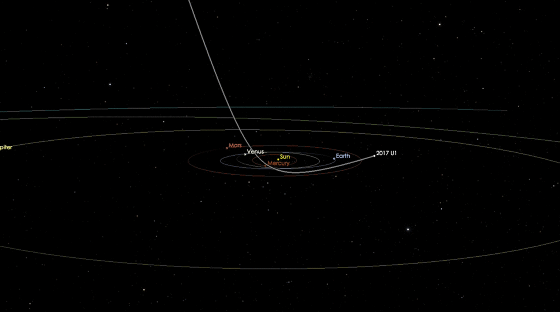"We were waiting for this decade for this day", confirmed a mysterious celestial body thought to have flew out of the solar system

The existence of a mysterious celestial body which seems to have come from outside the solar system was confirmed. Although the theory has existed the possibility that planets and comets move between stars and pass through the solar system, it has never been confirmed before. Paul Chodus of the Nebula Astrophysics Center said, "We have been waiting this day for decades."
Small Asteroid or Comet 'Visits' from Beyond the Solar System | NASA
https://www.nasa.gov/feature/jpl/small-asteroid-or-comet-visits-from-beyond-the-solar-system
Located in Haleakala, HawaiiPanstars 1The mysterious celestial body captured by the telescope on October 19, 2017 is "A / 2017 U1It is called. Rob Weryk, a doctoral researcher at the University of Hawaii Astronomical Research Institute (IfA) who first noticed the object, said, "The movement could not be explained by the movement of asteroids in the solar system or the orbit of comets," I am talking. Mr. Weryk is a European Space Agency ·SSA-NEO Coordination CenterAstronomerMarco MicheliAlthough I also contacted Mr. Micheli with the image taken by the European Space Agency, it was still the same conclusion that this celestial object came from outside the solar system ".
The A / 2017 U1 is less than 400 meters in diameter and is believed to have raised the speed to about 15.8 miles per second (about 25.5 km) per second when entering the solar system. The celestial body came from the direction of Kotoda approached the sun on September 9, 2017 and passed through the inside of Mercury's orbit. It is October 14th that I approached the Earth closest to about 15 million mile (about 24 million km), about 60 times the distance from the moon to the earth.
The orbit of a mysterious celestial body is as follows. A celestial body came from "above" the ecliptic ... ...

It passes inside Mercury's orbit and approaches the sun.

Then I departed from the sun by drawing a big curve.

After passing by the Earth, it seems that I could not afford to observe enough as I went away at 27 mph (about 43 km). "Although the A / 2017 U1 has already gone away, we are planning to track the location of the A / 2017 U1 over a period of one to two months using a huge telescope," Farnocchia says. However, it is possible that A / 2017 U1 may already be weakening too much in order to grasp the physical characteristics such as size, mass, composition and so on. In the survey so far, it was found that celestial bodies are not comets,Kuiper belt objectsWe know that it is a reddish shade like an asteroid.
Spectrum of A / 2017 U1 acquired on Wednesday night with the@INGLaPalma4.2 m WHT. Color is red like Kuiper Belt Objects, featureless.pic.twitter.com/utB1sqdjlV
- Alan Fitzsimmons (@ FitzsimmonsAlan)October 27, 2017
Davide Farnocchia of CNEOS says, "The orbit of this object is the most extreme I have ever seen," "Because it is moving at an extremely fast speed, from drawing such an orbit, I am confident that I will pass through the sun and will not come back. "
Karen Meech, IfA's astronomer, said: "We thought that such a celestial body would exist for a long time, as many substances are eliminated from the planetary system when the planet is made," And comments. Paul Chodas of CNEOS also said, "We have been waiting for the decades this day," that asteroids and comets are moving between stars and happen to pass through the solar system " It was theorized, but this is the first time that we have been detected.Therefore all the data shows that this object is an interstellar object, but to help further confirm the facts It will be. "
"The ability to observe interstellar objects in the solar system means that we are investigating the structure and dynamics of other solar systems.If the object is home the solar system is kicked out and entered our solar system If it had been, we can learn the history of composition of the solar system which is their home, "said Bonnie Meinke of the Space Telescope Science Institute.
Since NASA has observed only one planet that moves between stars in the 20 years since it began investigating dangerous asteroids, some researchers like A / 2017 U1 again while I was alive Some people think that it is difficult to observe objects. Although it is extremely rare, it is difficult to collect data, but if the telescope evolves and it becomes possible to observe such a heavy body frequently, like Arthur C. Clarke's novel came from outside the solar system Observing the object, actually it was a cylindrical artifact ... ... "may also happen.
Rendezvous of the Universe [Revised Edition] (Hayakawa Bunko SF) | Arthur C. Clarke, Arthur C. Clarke, Hiroshi Nanshan | Books | mail order | Amazon

Related Posts:
in Science, Posted by darkhorse_log







